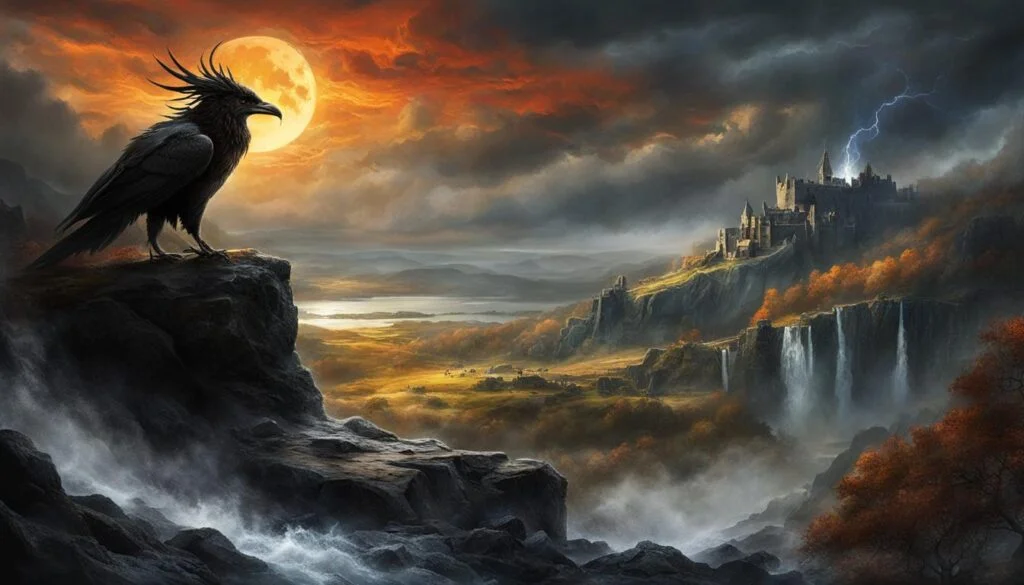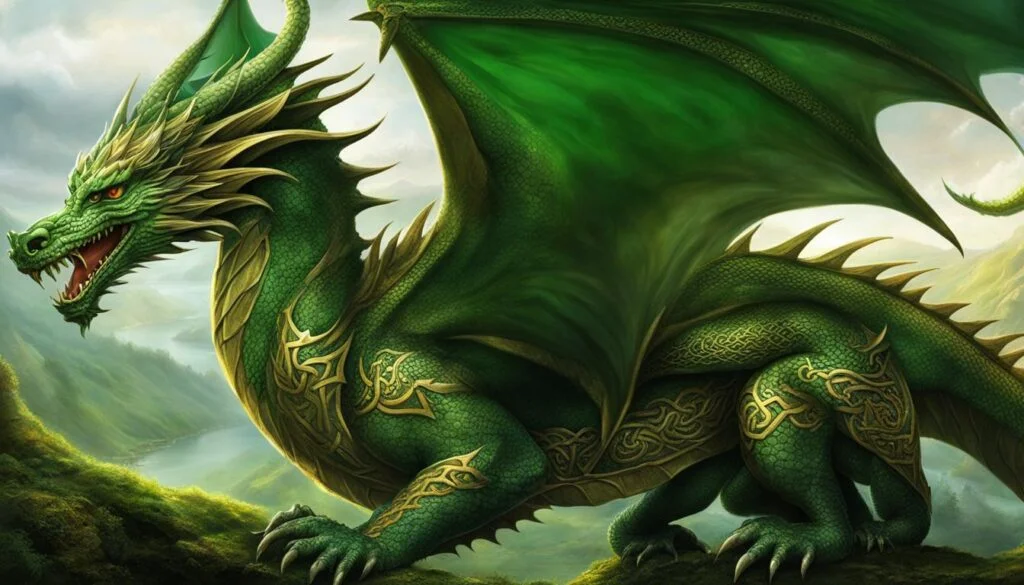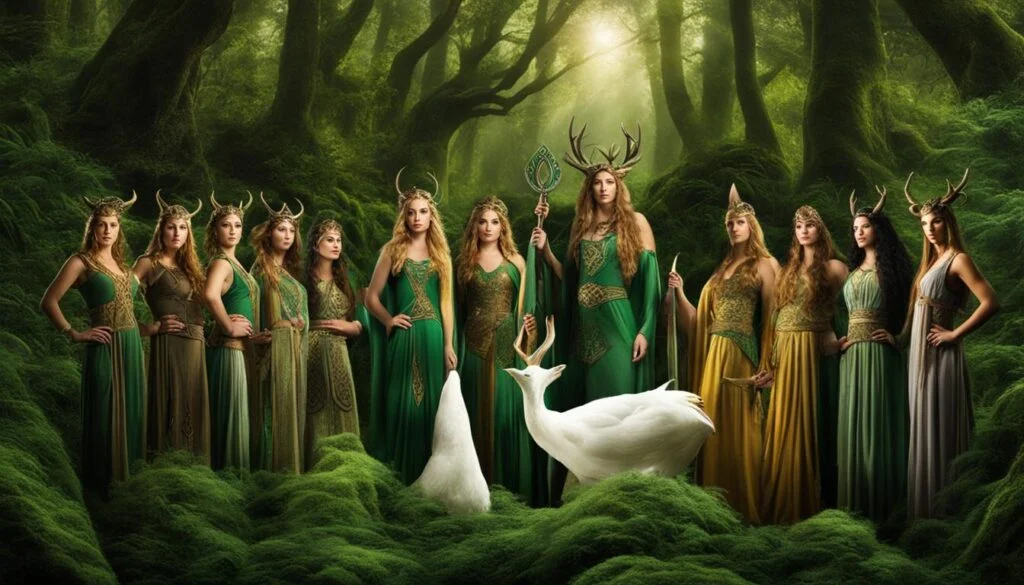In Celtic mythology, there are fascinating beliefs and legends surrounding the end of the world. While no complete stories exist, scattered hints and clues provide insight into the Celts’ perspective on the ultimate demise. It is believed that the Celts envisioned a final cataclysm or apocalypse, where fire and water would prevail over existence. The fear of the heavens falling upon their heads and the gradual transformation of the earth into its current form were also prevalent themes in Celtic mythology.
Key Takeaways:
- The Celts believed in a final cataclysm or event that would lead to the end of all things.
- There are scattered hints and clues suggesting the Celts’ fear of the heavens falling upon their heads.
- Celtic mythology depicts a gradual transformation of the earth into its current form.
- The exact details of the Celtic apocalypse myth are not well-documented.
- Celtic mythology offers a fascinating and complex perspective on the end of the world.
Celtic Creation Myth
While no complete Celtic myth describing the creation of the world has survived, it is possible to piece together the Celtic view of creation through cross-referencing multiple existing myths. One belief is that the druids, as masters of magic and spells, claimed to have created the sun, moon, earth, and sea using their control over the elements.
According to this belief, the druids possessed the magical ability to harness and manipulate the forces of nature. Through their connection with the natural world, they were able to shape the elements to their will and bring forth the fundamental aspects of existence.
Another intriguing aspect of the Celtic creation myth is the idea that the world was formed from the blood, flesh, or sweat of fairies or gods. This concept highlights the close relationship between the supernatural and the physical world in Celtic mythology.
The Celts believed that these divine beings played a vital role in the creation of the world, and their essence permeated every aspect of existence. It was through the sacrifice or contribution of these magical creatures that the world took shape and came into being.
Additionally, some myths suggest that the creation of the world involved the use of godlike magical items. These powerful artifacts held immense cosmic energy and were instrumental in shaping the fabric of reality itself. The use of magical objects emphasizes the importance of supernatural forces and the belief in the transformative power of these enchanted items.
The Celtic creation myth represents the deep reverence the Celts held for nature and their understanding of the interconnectedness between the physical and supernatural realms. It showcases the belief in the ability to wield magic and shape the very foundation of the world, combining elements of mysticism and spirituality that were central to Celtic culture.
Celtic Apocalypse Myth
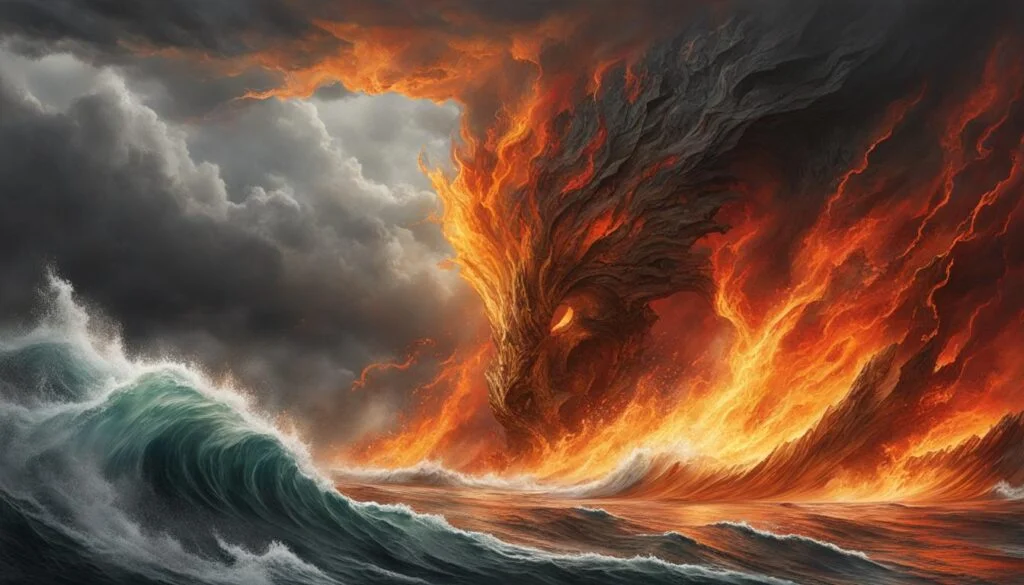
While no complete stories exist that describe the Celtic end of the world in the same way as the Norse Ragnarok, scattered hints and clues suggest that the Celts believed in a final cataclysm or apocalypse.
The Druids, influential figures in Celtic society, taught that fire and water would eventually prevail over existence, leading to the end of all things. The Celts held a deep-seated fear of the heavens falling upon their heads, symbolizing the ultimate demise.
These beliefs reflect the cyclical nature of the cosmos in Celtic mythology and the understanding that nothing in the world is eternal. Just as seasons change and cycles repeat, the Celtic worldview acknowledged that even the most powerful forces and structures would eventually come to an end.
The exact details of the Celtic apocalypse myth are not well-documented, leaving room for speculation and interpretation. However, the scattered hints and clues in Celtic mythology provide a fascinating glimpse into the Celts’ contemplation of the end of the world and the transient nature of existence.
The Otherworld in Celtic Mythology
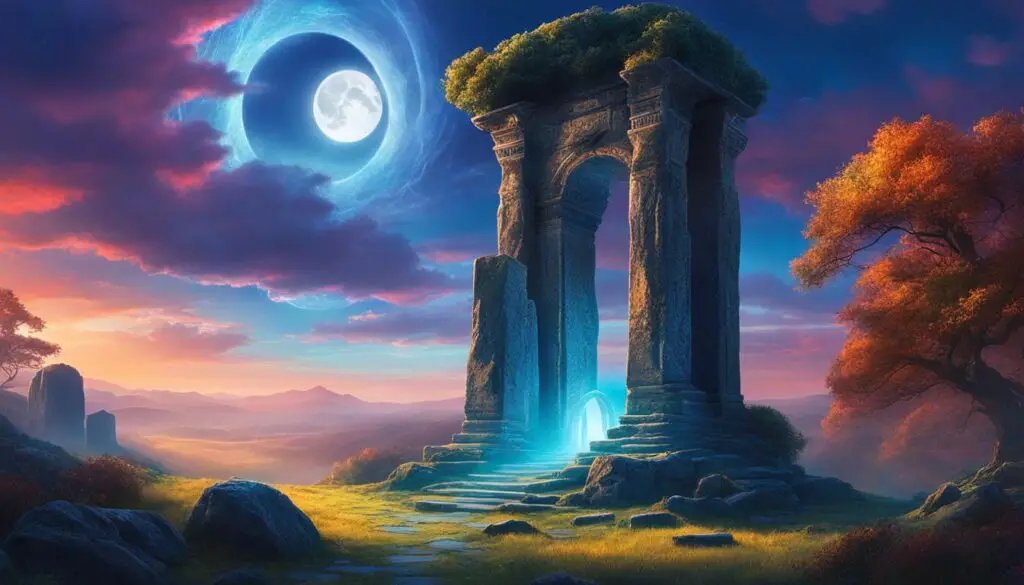
In Celtic mythology, the Otherworld is a supernatural realm that exists as a parallel world alongside our own or as a heavenly land beyond the sea or under the earth. It is a place of everlasting youth, beauty, health, abundance, and joy. In this supernatural realm, time flows differently than in our mortal world, and its inhabitants possess extraordinary powers and qualities.
The Otherworld is often described as a realm of enchantment and wonder, where the laws of nature are different and magical beings reside. It is a supernatural realm inhabited by fairies, spirits, gods, and heroes from ancient times. In this parallel world, mortal humans can experience extraordinary adventures, encounter mythical creatures, and partake in extraordinary feats.
Various entry points to the Otherworld are mentioned in Celtic myths, providing glimpses into how one can gain access to this hidden realm. Ancient burial mounds, caves, waterways, and the western sea are often considered gateways to the Otherworld. These entry points act as portals, transporting individuals from our ordinary human experience to the extraordinary realm of the Otherworld.
Heroes in Celtic mythology, such as Cúchulainn and Fionn, often visit the Otherworld either through chance encounters or by being invited by its residents. These heroes are granted rare opportunities to venture into this supernatural realm, where they undergo trials, gain wisdom, and acquire magical gifts.
The concept of the Otherworld in Celtic mythology represents a belief in the existence of a parallel reality where everlasting beauty, youth, and abundance prevail. It offers a glimpse into the Celtic imagination and their longing for a realm beyond the ordinary, where the boundaries between the mortal and the divine are blurred, and the wonders of the supernatural realm can be experienced.
Entry Points to the Otherworld:
- Ancient burial mounds
- Caves
- Waterways
- The western sea
Otherworld Names and Beliefs in Celtic Mythology
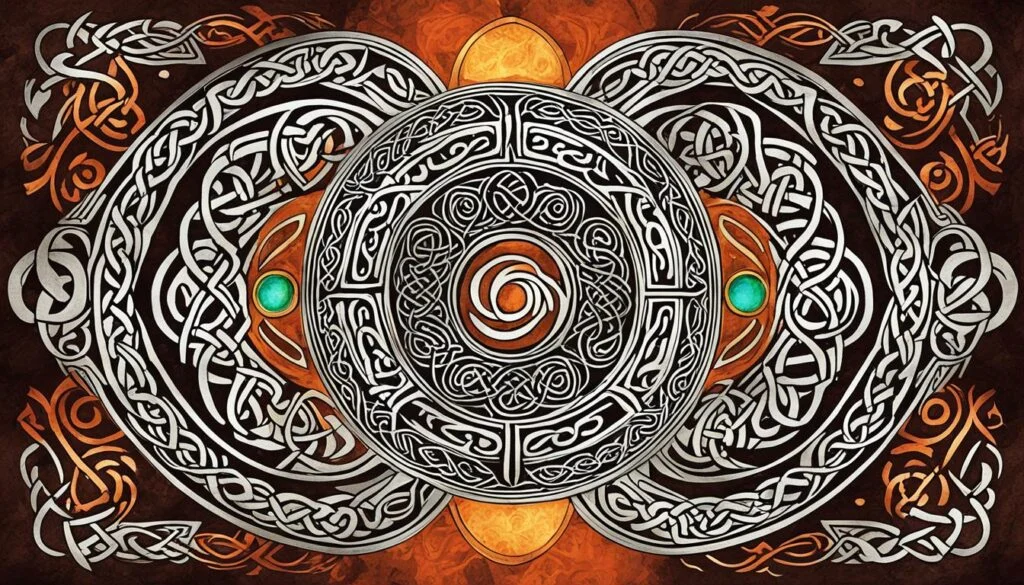
The Celtic mythology is rich with various names for the Otherworld, each reflecting unique beliefs and regional variations. In Irish mythology, the Otherworld is referred to as Tir na nOg (land of the young), Mag Mell (plain of delight), and Emain Ablach (isle of apples). These mystical realms are associated with everlasting youth and abundance, offering a glimpse into a realm beyond our own.
In addition to these names, Irish myth also mentions Tir fo Thuinn (land under the wave), Tir na mBeo (land of the living), and Tech Duinn (house of Donn) as entry points to the Otherworld. These representations indicate the diverse understanding of the supernatural realm within Celtic culture.
Welsh mythology offers its own names for the Otherworld, known as Annwn or Annwfn. It is ruled by the kings Arawn and Gwyn ap Nudd, and like the Irish Otherworld, it is often associated with beauty, magic, and otherworldly beings.
Continental Celtic mythology, particularly among the Gauls, depicted three parts of the universe. Albios represented heaven, Bitu symbolized the world of the living, and Dubnos encompassed the realm of the dead. These three components reflect the Gauls’ beliefs about different realms and their place within the cosmic order.
Overall, the multitude of names for the Otherworld in Celtic mythology highlights the diversity and depth of Celtic beliefs and the significance of these mystical realms within their cosmology.
Key Points:
- In Irish mythology, the Otherworld is called Tir na nOg, Mag Mell, and Emain Ablach.
- Otherworldly realms in Irish myth also include Tir fo Thuinn, Tir na mBeo, and Tech Duinn.
- Welsh mythology refers to the Otherworld as Annwn or Annwfn.
- Continental Celtic mythology includes Albios, Bitu, and Dubnos as distinct parts of the universe.
Conclusion:
Celtic mythology provides a fascinating perspective on the end of the world. Although there are no complete stories that describe the Celtic version of the apocalypse, scattered hints and clues indicate that the Celts believed in a final cataclysm that would bring about the end of all things. This belief reflects their understanding of the cyclical nature of the universe and the impermanence of existence.
Another significant aspect of Celtic mythology is the Otherworld, a supernatural realm characterized by eternal youth and beauty. This parallel world or heavenly land was believed to exist alongside our own, and it played a significant role in Celtic storytelling. The Celts had various names for the Otherworld, reflecting the diverse regional and cultural variations within Celtic mythology.
In summary, Celtic mythology offers a deep and intricate understanding of the world’s end and the existence of other realms beyond our own. While the specifics may not be fully documented, the scattered clues and hints found in Celtic folklore provide a glimpse into the Celts’ contemplation of the final cataclysm and the enchanting Otherworld.
FAQ
How does the world end in Celtic mythology?
In Celtic mythology, there are scattered hints and clues suggesting a belief in a final cataclysm or apocalypse. The Druids taught that fire and water would eventually prevail over existence, leading to the end of all things. The Celts also feared that the heavens would fall upon their heads, signaling the ultimate demise.
What is the Celtic creation myth?
While no complete Celtic creation myth has survived, it is believed that the druids claimed to have created the sun, moon, earth, and sea using their control over the elements. Another belief suggests that the world was created from the blood, flesh, or sweat of fairies or gods, or through the use of magical items.
Are there legends about the end of the world in Celtic mythology?
While no complete stories exist, scattered hints and clues in Celtic mythology suggest a belief in a final cataclysm or apocalypse. The Druids taught that fire and water would eventually prevail over existence, leading to the end of all things. The Celts feared that the heavens would fall upon their heads, signaling the ultimate demise.
What is the Otherworld in Celtic mythology?
The Otherworld is a supernatural realm described as a parallel world that exists alongside our own or as a heavenly land beyond the sea or under the earth. It is a place of everlasting youth, beauty, health, abundance, and joy. Heroes in Celtic mythology often visit the Otherworld through ancient burial mounds, caves, waterways, and the western sea.
What are the names for the Otherworld in Celtic mythology?
In Irish mythology, the Otherworld is known as Tir na nOg, Mag Mell, and Emain Ablach, among others. In Welsh mythology, it is called Annwn or Annwfn. Among the Gauls, the Otherworld is believed to consist of Albios (heaven), Bitu (world of the living), and Dubnos (hell). The names reflect the diverse beliefs and regional variations within Celtic mythology.
In summary, what does Celtic mythology tell us about the end of the world?
Celtic mythology offers a unique and intriguing perspective on the end of the world. While no complete stories exist, scattered hints and clues suggest a belief in a final cataclysm or apocalypse. The Celts feared that fire and water would prevail over existence, and the heavens would fall upon their heads. The Otherworld also plays a significant role in Celtic mythology as a supernatural realm of everlasting youth and beauty.


